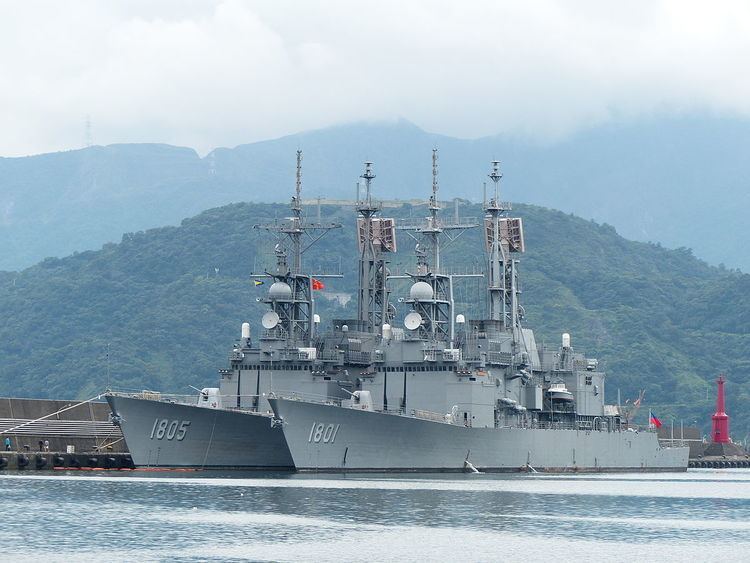Name Kidd-class destroyer | Built 1978 | |
 | ||
Preceded by Spruance-class destroyer Succeeded by Arleigh Burke-class destroyer | ||
The Kidd-class guided missile destroyers (DDGs) were a series of four warships based on the Spruance class destroyers. The Kidds were designed as more advanced multipurpose ships, in contrast to their predecessor's focus on anti-submarine warfare, adding considerably enhanced anti-aircraft capabilities. Originally ordered for the former Imperial Iranian Navy, the contracts were canceled when the 1979 Iranian Revolution began, and the ships were completed for the U.S. Navy. Because they were equipped with heavy-duty air conditioning and other features that made them suitable in hot climates, they tended to be used in the Middle East, specifically the Persian Gulf itself. During their service with the U.S. Navy from the 1980s to the late 1990s, the ships were popularly known as the "Ayatollah" or "dead admiral" class. They were decommissioned and sold to Taiwan, now being known as the Kee Lung-class.
Contents
History
These ships were originally ordered by the last Shah (king) of Iran for service in the Persian Gulf, in an air defence role. The Shah was overthrown in the Iranian Revolution, prior to Iran accepting delivery of the ships, causing the United States Navy to integrate the vessels into its own fleet.
Each ship in the class was named after a U.S. Navy Admiral who had died in combat in the Pacific in World War II:
In 1988–90, the Kidds’ received the “New Threat Upgrade”, which allowed cooperative engagement with Aegis Ticonderoga-class cruisers, enabling the cruisers to control the Kidds’ surface-to-air missiles in flight while the destroyers remained electronically silent. However, the arrival of the Aegis-equipped Arleigh Burke-class destroyers led to the accelerated retirement of the Kidd class.
All four ships were decommissioned from the U.S. Navy in the late 1990s, and were initially offered for sale to Australia in 1997 for A$30 million each. In 1999, the offer was rejected, based on extensive problems the Royal Australian Navy had encountered during the acquisition of two surplus Newport class tank landing ships from the U.S. Navy in 1994. After the Australian refusal, the four ships were offered to Greece, which also refused.
Sale and reactivation
In 2001, the U.S. authorized the reactivation and sale of all four ships to Taiwan. All four have been transferred to the Republic of China (Taiwan) Navy under the Kuang Hua VII program. They were sold for a total price of US$732 million with upgraded hardware, overhaul, activation, and training, included a reduced missile loadout of 148 SM-2 Block IIIA and 32 RGM-84L Block II Harpoon anti-ship missiles. The reactivation was done in Charleston, South Carolina, by VSE/BAV.
Kee Lung-class destroyers
The first two ships, ex-Scott and ex-Callaghan, arrived at Su-ao, a military port in eastern Taiwan, in December 2005, and were named Kee Lung (DDG-1801) and Su Ao (DDG-1802) in a commissioning ceremony on 17 December 2005. Following the tradition of ship class naming, ROCN has referred these vessels as Kee Lung class destroyers. The remaining two units, ex-Kidd and ex-Chandler, were delivered in 2006, and named Tso Ying (DDG-1803) and Ma Kong (DDG-1805), respectively.
The opposition-led Legislature Yuan originally allocated only enough money to purchase half of the SM-2 missiles that the destroyers can carry; a further purchase of 100 supplemental SM-2MRs was included in the 2007 annual budget to ensure all four ships had a full load of SM-2.
By end of 2008, DDG-1802 Su Ao was spotted to have eight HF-3 AShMs installed in place of eight Harpoon AShMs. It has been speculated from 2014 on that a navalized Sky Bow missile system, currently planned for an upcoming shipbuilding programme that involves the procurement of three or four air defense frigates, will also be replacing the Standard Missile system on these destroyers.
